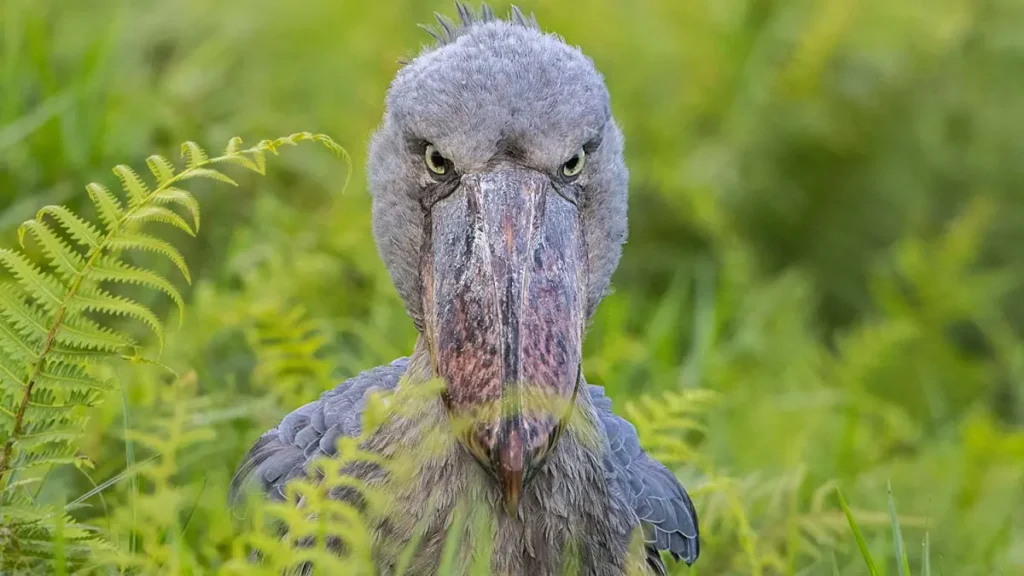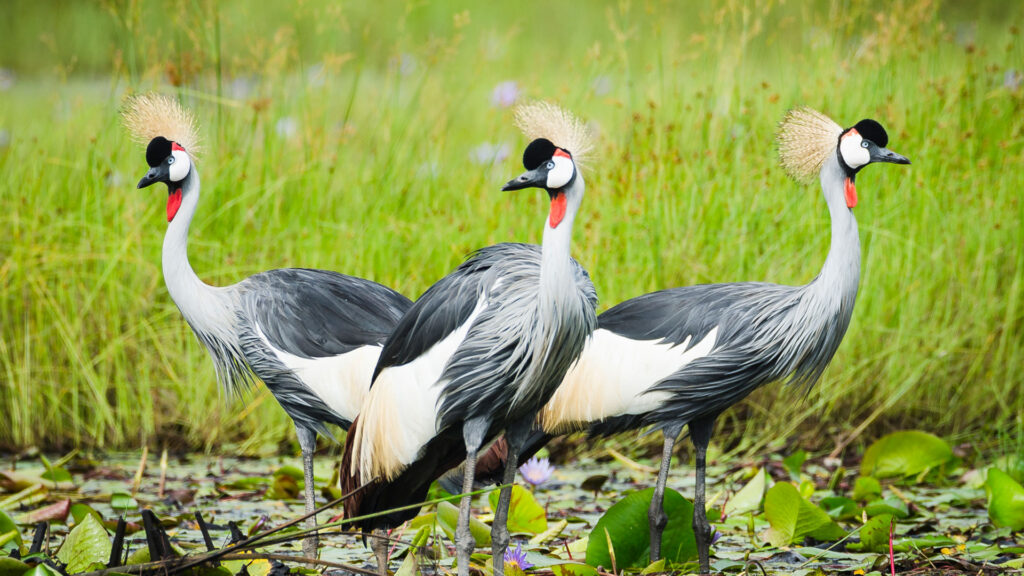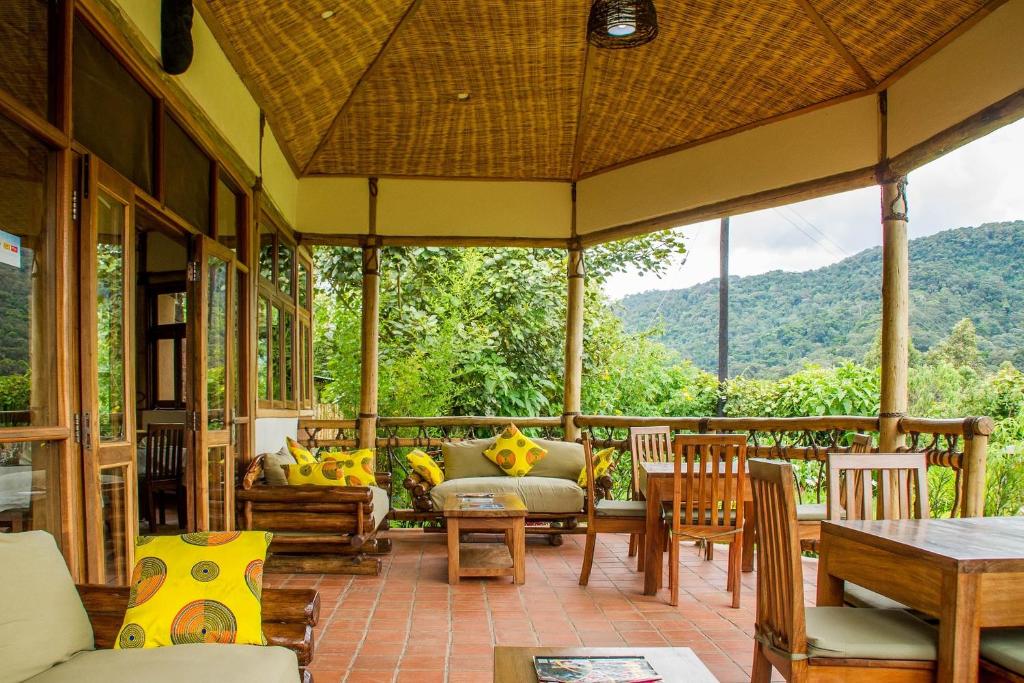
Mabamba swamp
Mabamba swamp.
Mabamba swamp : Uganda’s Mabamba Bay Swamp is a great safari destination to see birds because it is a wetland. It is known for the Shoebill, which is the most sought-after bird in Uganda by both tourists who want to see birds and nature fans. Mabamba Swamp is on the northern side of Lake Victoria, west of Entebbe. It is 2424 ha in size and has thick marshes of papyrus, water lilies, and other wetland grasses.
Mabamba swamp is an Important Bird Area (IBA) and a Ramsar site. The wetland is home to more than 300 bird species, including many that are endangered around the world, 7 of Uganda’s 12 species that can only live in the Lake Victoria biome (one of the most famous is the Papyrus Gonolek), and many species that only live in wetlands. Mabamba swamp impressive bird watching safari destination is also home to a lot of Palearctic migrants from October to March every year.
There are several ways to get to Mabamba Swamp. From Kampala or Entebbe, the quickest way to get to Mabamba is to take the ferry from Entebbe’s Nakiwogo landing site to Kasanje landing, which takes about 10 minutes. From Kasanje landing, it takes about 20 minutes to drive to Mabamba through farms and open fields, where you can see lots of garden birds. Bird watching safari in Mabamba swamp is done from a motorized wooden boat that goes through a maze of tracks that cut through the thick marshes.
Shoebill, which lives in Mabamba swamp, is the bird that Ugandan birdwatchers want to see the most. The Shoebill is also on the wildlife list of people who don’t like to watch birds but are still interested in it because of how strange it looks and how big it is. The Shoebill is a rare bird that only lives in a few places in Uganda. Mabamba Swamp is the perfect safari destination to see the Shoebill in Uganda, and maybe even in all of Africa.

Lungfish, which are called “mamba” in the local language, are plentiful in Mabamba Swamp. This is the Shoebill’s favorite food. But the lungfish is one of the fish that local fishers want the most, so it competes with the Shoebill. The fishermen had long believed that seeing a Shoebill, which they called “Boolwe” in their language, meant that they wouldn’t catch much that day. But this isn’t too far-fetched because the Shoebill eats lungfish, and fish will hide where the Shoebill is. When hunters went out to fish in the wetland, seeing a Shoebill was a bad sign. They went looking for the Shoebills and killed them, which caused their numbers to drop and almost wiped them out in the marsh. In 2006, the swamp was named a Ramsar site, which helped protect the Shoebill.
Bird watching safari on the wetland, on the other hand, taught the fishermen and the rest of the society a lot. The fishermen make a lot of money by renting out their boats to people who want to watch birds. Some of the fishermen have even taken classes to learn how to watch birds and lead tours. Now, the fishers protect the Shoebill. When they go fishing and see one, they don’t get too close so they don’t scare it, and they are happy to tell tourists where they can see one. It is thought that about 12 Shoebills live in Mabamba swamp.
Best time to visit Mabamba swamp.
The best time to see the Shoebill in Mabamba swamp is early morning, say 7am, before there is more activity on the wetland but also by this time the Shoebill is in search for lunch fish which it does by standing in one place for a long time or even hours looking out in the water waiting for fish to cross so it scoops it with the big strong shoe-like bill that breaks the fish instant.
Other Mabamba Swamp birds;
African Fish Eagle, Purple Swamphen, African Green Pigeon, African Jacana, African Marsh Harrier, African Pigmy Goose, Black Crake, Black Heron, Black-crowned Night Heron, Black-crowned Waxbill, Black-headed Heron, Black-winged Stilt, Blue Swallow, Blue-cheeked Bee-eater, Black Crake, Black Heron, Black-crowned Night Heron, Black-crowned Waxbill, Black-crowned Waxbill Cattle Egret, Common Moorhen, Common Sandpiper, Common Sqacco Heron, Double-toothed Barbet, Glossy Ibis, Goliath Heron, Great Cormorant, Great White Egret, Great White Pelican, Green Cuckoo, Grey Heron, Grey-crowned Crane, Great Cormorant, Great White Egret, Great White Pelican, Green Cuckoo, Grey Heron, Grey-crowned Crane, The Gull-billed Tern, Little Egret, Little Stilt, Hadada Ibis, Harmerkop, Cormorant with a long tail, Lapwing with long toes, Malachite Kingfisher, Marsh Harrier, Northern Brown-throated Weather, Orange Weaver, Papyrus Gonolek, Pied Kingfisher, Pied Wagtail, Pink-backed Pelican, Pin-tailed Whyda, Pin-tailed Whyda, Purple Heron, Red-eyed Dove, Red-headed Love-bird, Shining Blue Kingfisher, Speckled Mousebird, Spur-winged Goose, Spur-winged Lapwing, Swamp Flycatcher, Veilots’ Black Weaver, Village Weaver, Water Thicknee, White-browed Cuckoo, White-faced Whistling Duck, White-throated Bee Black-headed Weaver, Yellow-billed Duck, and Yellow-billed Kite.
If you’re a serious birder who wants to get the most out of your time in Mabamba and see a lot of birds, you can explore more habitats and places near the wetlands. Here’s what your hiking route will look like in Mabamba:

Birding around the Mabamba landing site/parking.
Even before you go out into the wetland, you can see some nice birds at the Mabamba landing spot and parking area. There are a lot of birds in the tall trees, bushes, and thickets, and you might see a lifer or something special. So, you can spend a few minutes or an hour looking at the environments before getting on a boat to explore the Mabamba wetland’s waterways.
The beautiful Superb Sunbird has been seen here a lot. It is often seen in short trees and bushes, picking insects off of tree branches before running into an angry Red-chested Sunbird, which is only found in the Lake Victoria biome and is everywhere.
Other birds that are often seen are the Yellow-breasted Apalis, Weyn’s Weaver, Village Weaver, Vieillot’s Black Weaver, Grey-capped Warbler, Yellow-throated Greeenbul, Splendid Starling, Brown-throated Wattle-eye, Lesser Striped Swallow, Swamp Flycatcher, etc.
Birding on water – looking for the Shoebill and wetland specials.
At Mabamba wetland, you can watch birds from a motorized wooden canoe or boat. There are lots of boats, and local people are eager to take you to see the Shoebill. As soon as you get into the boat, you should start looking for the Shoebill. The fishermen who go out early in the morning to see what they got in their nets can sometimes help find where the Shoebill was seen. If not, it will be a game of looking in the grasses where the Shoebill loves to hunt.
Morning time is the best time to see the Shoebill when it is following lungfish by standing still for long even hours without movement until an unlucky fish crosses its path. When it gets hot later in the day, the Shoebill rests by spreading out its wings and sitting in the grass. This makes it hard to find. It can also be seen cooling off by flying high in the sky.
After seeing the Shoebill, go back to birding as usual, exploring the many waterways that lead to Lake Victoria and deep into the swamp by wading through thick papyrus and grasses.
Purple Swamphen, African Marsh Harrier, African Darter, Common Squacco Heron, Purple Heron, Long-tailed Cormorant, Northern Brown-throated Weaver, Yellow-billed Duck, and Malachite Kingfisher are some water birds that are hard to miss. Along the edge of the Mabamba wetland, there are fields and forests where you can watch birds. You can end your birding safari at Mabamba and add to your list of field species by walking along the nice trail that goes along the wetland.
When you get back from your boat ride on the Mabamba swamp, you can take this trail, which starts just before the exit on your left. Along the wetland, the path goes through fields and bushland. It also goes by a plantation of eucalyptus trees, which is not very rich but can have some interesting forests species. Because the path is so long, you can walk for a few hours until you feel like you’ve had enough. Some popular birds are the Rufous-napped Lark, Sooty Chat, Grassland Pipit, Red-bellied Paradise-Flycatcher, Lizard Buzzard, cuckoos, weavers, scrub-robins, sunbirds, etc.

Birding in Nkima Forest.
A small patch of forest called Nkima Forest is on a hill and looks out over the Mabamba swamps. It is about 2 kilometres from the Mabamba landing spot and only 20 minutes on foot from Mabamba. Even though Nkima forest isn’t as big as Mabira forest, it’s still a good birding safari destination to see birds. It’s a nice addition to the water and field birding you can do at Mabamba wetlands. If you want to spend a day birding in Mabamba Wetlands and the area around it, Nkima Forest is a forest environment that you can visit to add more forest species to your list of birds. Some forest specialties that you might not see often in big forests will surprise you in Nkima Forest. It is a young forest going by the thick undergrowth.
The best place to start birdwatching safari in Nkima Forest is at the Nkima Forest Lodge, which is on top of a hill. From there, different trails lead into the forest. The clearing around the lodge is a nice spot to start, you see several species on fruiting and flowering trees and shrubs at the edge of the forest. It’s hard to miss the Green Sunbird, Grey-headed Nigrofinch, and Weyn’s Weaver here. If you look higher up into the treetops, you’ll see more birds, like cuckoos, hornbills, bee-eaters, wattle-eyes, etc. After going through the grassy clearing at the top of the hill, you can look for specials in the forest. The shy but loud White-tailed Fluff tail is at the top of the list, and if you play its call in Nkima forest, you’ll probably see it every time. Other species that are likely to be seen in the region are Western Nicator, Red-capped Robinchat, Tambourine Dove, Scally Francolin, etc. Aside from birds, there are many other animals in Nkima Forest, such as monkeys, mice, bushbabies, etc.







